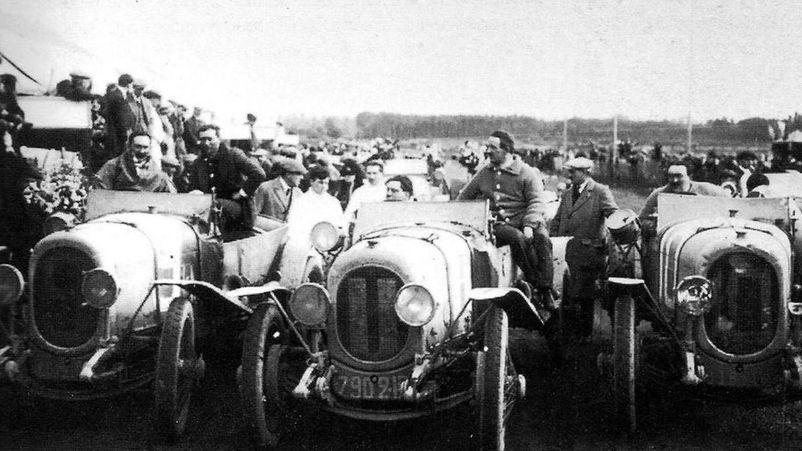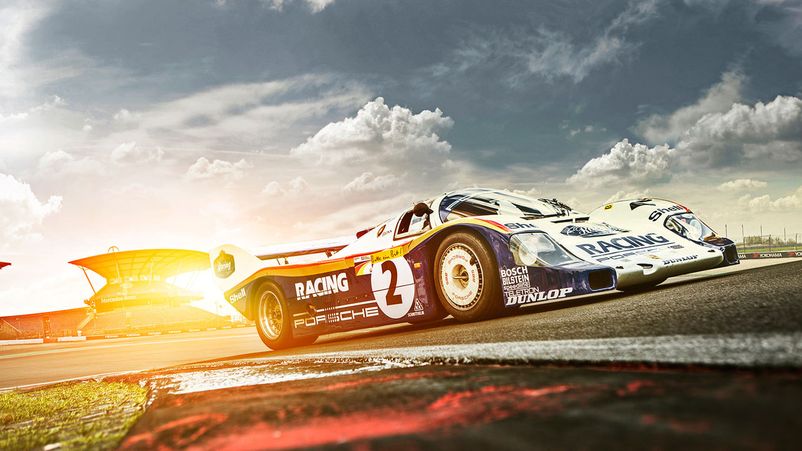The 24 Hours of Le Mans (24 Heures du Mans) is the most famous and prestigious endurance race world over, helded in France annually, since 1923. The race take a place on the Sarthe circuit. There the audience for the first time witnessed the champagne fountain on the pedestal. The race has its own traditions - the waving of the national flag is symbolized the race beginning, and the last lap is symbolized by the safety flags.

The origin of the competition
The Sart Motorists Union is the ancestor of the race, which appeared in 1906 at Le Mans and which organized it for the first time in 6 years. And in 1906 - Grand Prix of France. On May 26, 1923, the race occurred, which became the peak of the evolution of the competition. After that, they became regular. The owner of the gold was the partaker whose car suffered the least damage and was first at the finish.

ROUTE - CIRQUIT DE LA SARTHE
Most feck of the "Sart" consists of roads of public use. Having endured for a few changes, the route has decreased from 17 km to 13.65 km. Prior to 1990, riders had to overcome a 5-kilometer straight section where two chicanes met to prevent speeding.

PART OF OTHER ENDURANCE CHAMPIONSHIPS
On the aforementioned track there are also held other competitions. As example is the one organized by the Western AutoClub, which is the FIA WEC (World Endurance Championship) part.

PURPOSE OF THE COMPETITION
Additionally to the speed record, the primary task of racing is also the preservation of the maximum safety and reliability of the car. While choosing a champion, the number of laps that the driver completed per day and the level of resource loss are taken into account. The important thing is to keep the auto in good condition and achieve the best performance in the race. In the early stages, the rules forbade refueling with anything other than fuel within an hour as from the start.
Anyway, getting to the finish line of the race is already a victory.
Debut
The first race the viewer saw on 26-27 of May 1923. Later, the contest was arranged on the second Junees weekend.

Qualification
Until 1963, the decisive factor in assigning a position at the start of the racer was set by the dimention of his car’s engine. Further it was decided to introduce pre-qualification. And according to its results, the number at the start was defined.

Le Mans start
The go-off of each participant began near the boxes, despite the fact that the pilot stood on the opposite side and had to get into the car himself, buckle up, start the engine and then begin the race. The first place will get the one who completed the most laps in the set time.

Since 1971, due to the large number of casualties, a rolling start has been introduced, taking into account which victory is ensured by passing the maximum distance.
Numerous deaths were the cause. Many pilots, trying to take off as quickly as possible, did not fasten their seat belts or, before they could get to the car, were shot down by other participants.
EQUIPMENT USED IN THE 24 HOURS OF LE MANS
In the marathon competed 4 classes of cars:
- Le Mans Prototypes (LMP): 2 top-class LMP1 and LMP2
- Since 2011, two Gran Turismo classes: GT Endurance Pro and GT Endurance AM.

PILOTS
Until 1980, the rules did not set a limit on the number of pilots, but after that only 3 pilots from one team were approved. Another 10 years later, they set a limit on the time the pilot was behind the wheel. One rider could drive no more than 4 hours in a row and 14 hours in total.

THE BIGGEST ACCIDENT IN THE HISTORY OF MOTORSPORTS
There were many accidents in the competitions.
- Pilot Joe Gartner was dead due to a clash with a fence in 1986.
- In 2011, an Audi crashed into a fence and lost traction as a result of a collision with a Ferrari GT.

But that's not all...
DESCRIPTION OF THE PROBLEM
The largest accident occurred on June 11, 1955. Mercedes-Benz 300 SLR of Pierres Leveg, after clash with an Austin-Healey 100, was thrown into an earthen embankment that separated the road and spectators. The car broke into pieces which flew into the crowd. More than 80 people died, including the driver, who received a head injury incompatible with life.

THE REASON OF THE ACCIDENT
Due to the high speeds, Levegh did not have time to avoid a bump with an Austin-Healey 100, which, in his turn, tried to bypass a Jaguar D-Type that had braked sharply. As a result of the collision, the car lost contact with the ground and flew into the fence.

CONSEQUENCES OF THE ACCIDENT
As a result of the tragedy, 84 spectators died, another 178 were injured. Countries such as Spain, Germany, Switzerland and France have banned motor racing after this. Around the world, security measures have been revised and increased. Next year most were trying to lift the ban on auto racing. The outcome of the official investigation denied the fault of the pilots in the incident, the reason was insufficient security.
RACING HISTORY BY DECADES
- 1923-1939

The first race was held in 26th of May 1923. At the same time the first accident happened. The pilot who finished the race already fell under the wheels of another participant, as a result he was injured. Further, in connection with the WW II, the races were not organized within next decade.
- 1949-1969
The 24 Hours of Le Mans resumed in 1949. The list of participants has expanded. Increasing fame and popularity contributed to a shift in the balance towards higher speeds (to the detriment of safety), and in 1955 there was a terrible accident in which several dozen spectators and the pilot died.
This tragedy contributed to increased attention to security issues. At the 1960s end, the era of specially prepared production cars, which until then had an advantage, comes to an end.

- 1970-1980

In the 1970s, the era of more powerful fireballs, respectively, high speeds, begins. Start from a place is replaced by a start from a running start. In this decade, Porsche becomes the undisputed leader.
- 1981-1993
During these years, strong positions were occupied by Mercedes-Benz and Jaguar, and Japanese cars also showed themselves a little. Peugeot 905 took the lead in the race in the early 90s. At the same time, in order to avoid exceeding the max speeds, chicanes appeared on the 5-kilometer Mulsanne straight.

- 1994-1999
Special serial cars were permitted to compete in 24 Hours of Le Mans. The BMW V12 LMR took a gold in 1999, what become the first BMW's win in Le-Man.

- 2000-2005
As the worth of participation in the race grew, in the early 2000s, the number of participants noticeably decreased. Leading position was taken by Audi (R10).
OTHER SERIES
There are also other Le Mans series: Asian, European and American.
EUROPEAN SERIES
In 2003 Western Autoclub (France) began to deal with the stages arranged in Europe, which marked the beggining of the European Le Mans Series. During the first year, only one stage was organized, and in the next one already 4. Later on, the series became regular and included 4-5 stages.

AMERICAN SERIES
American businessman Don Panoz has entered into an agreement with the Western Auto Club of France (ACO) to create an analogue of the Le Mans 1000 kilometers race in the US. The competition was held in 1998, and the next year the championship became known as ALMS (the American Le Mans Series). In 2000, the series sought to expand the geography to include races at Silverstone, Nurburgring and Adelaide, but the attempt failed.

ASIAN SERIES
The Asian Le Mans Series is a racing series that includes several auto races organized in Asia, subject to the rules adopted in the 24 Hours of Mans race.

24 HOURS OF LE MANS RACE AS AN ENGINE OF PROGRESS
To overcome the difficulties of the track in the marathon, updates of car design regularly appear, automakers have developed and are developing non-trivial technical solutions. The series spawned many novelties in motorsport. Innovations were either dictated by rules or created as a result of competition.

AERODYNAMICS
Due to the presence of long straight sections on the track, the main advantage of the cars was the ability to develop maximum speed. Paying great attention to this indicator, providing the necessary downforce for turning has moved to another plan. Bugatti was the first who focused on this. There was a trend towards smoothing the shape and streamlining of the car, which did not allow lifting off the ground, taking off into the air, due to the high air pressure on the rear part of the car.

ENGINES
When choosing an engine for the competition, not only the ability to reach maximum speed was taken into account, but also parameters such as fuel efficiency and the time required for refueling. In 1929 supercharging appeared, and in 1974 turbocharging. Mazda was the only victorious car with a rotary engine (which was banned later). Alternative heat sources have been used since 1949, and since 2009 cars with hybrid engines have been allowed to participation.

BRAKES
The need for more efficient braking systems grew with speeds increasing on the track. Disc brakes first came into sight in 1953. Two years later, Mercedes-Benz surprised everyone with its aerodynamic brakes. Anti-lock braking systems (ABS) became an innovation on sports prototypes in the 1980s, and in the 1990s, carbon-based composite brakes were introduced.

SUCCESS FOR MANUFACTURERS IN 24 HOURS LEMANS
Porsche, Alfa Romeo, Audi, Ferrari, Jaguar, Bentley, Mazda, Ford are the ones who took the gold. Most often it was received by Porsche (19 wins), Audi (13) and Ferrari (9).

Since 2000, the lidership has been taken over by the Audi team. Jaguar has 7 wins. Mazda is the only team fm Japan to have won the Le Mans Marathon (until the 2010s).
CULTURAL VALUE
JACKIE CHAN'S TEAM AT LE MANS
The Jackie Chan DC team was co-founded by actor Jackie Chan in 2016 and in 2017 the team won the competition by winning the LMP2 category, finishing second overall.
The Jackie Chan DC team still compete in 24 Hours of Le Mans.

MOVIES
Le Mans. In 1971, the premiere of a film about racing took place, where the role of Michael Delaney (the pilot of a Porsche in the Persian Gulf) was played by Terence Steve McQueen, an American film actor, auto and motorcycle racer, who also acted as a director and producer of the film.

In 2019, the film "Ford v Ferrari" was filmed, where Ken Miles is played by famous actor Christian Bale. In Europe and the UK, the picture was released under the title "Le Mans '66".
Michel Vaillant: Need for Speed. In the center of the plot is the 2002 marathon, the main character is Michel Vaillant, a fictional race car driver, champion of many world car competitions.
GAMES
The 24 Heures du Mans race has been the subject of some racing video games such as Gran Turismo, a series of racing games developed by Polyphony Digital, and Race Driver: GRID, a racing video game developed and published by Codemasters (the seventh game in the TOCA series).

BROADCASTS
In 2008, a multi-year agreement was signed with Eurosport to broadcast the entire marathon, including qualifications and races, on Eurosport and Eurosport 2. Motors TV broadcasts the races in 2006 and 2007. The live broadcast takes place on television or Internet still.

CLASSIC CAR RACING
LEGENDS OF LE MANS
"Legends of Le Mans" - competitions held during the race with the participation of only those cars that have already participated in the competition. The famous British pilot Stirling Moss is constantly present among the permanent pilots.

LE MANS CLASSIC
The Le Mans Classic is a vintage racing car competition held on the Sarthe circuit. First held in 2002.






